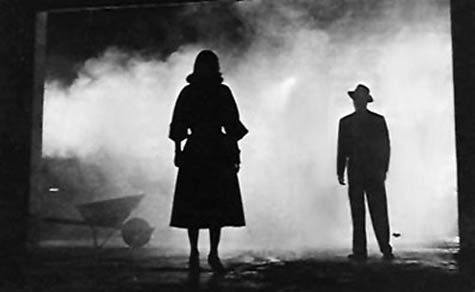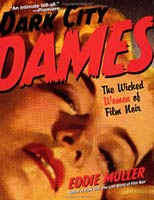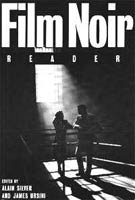
In recent years, film noir studies have exploded in popularity. For anyone just beginning their film noir obsession (or anyone who’s always ready to add to their home library) here’s a handy guide to some of the best books out there.
 1. Dark City: The Lost World of Film Noir; Dark City Dames: The Wicked Women of Film Noir; The Art of Noir by Eddie Muller. In the interest of full disclosure, I should say that I write for Noir City, the journal published by the Film Noir Foundation, which Eddie Muller runs. The reason I started working for the FNF, though, is because I was such a fan of these three books. Dark City is, for my money, the single best introduction to film noir you’ll find. Deeply researched, it’s structured as a “tour” through the cumulative city of film noir with chapters like Vixenville (femme fatale plots), Shamus Flats (the private eye flick), and Knockover Square (heist movies). Packed full of great movie stills, the book is written with Muller’s trademark encyclopedic knowledge and infectious love of the genre. Dark City Dames examines the life stories of six noir goddesses—Evelyn Keyes, Marie Windsor, Ann Savage, Coleen Gray, Audrey Totter, and Jane Greer. In the first half of the book Muller recounts the noir careers of these indispensible stars, and then in the second half he catches up to them decades later and interviews them about their lives in and out of the movie business. The first half of the book is fascinating; the second half is heartbreakingly beautiful. The Art of Noir is a coffee table collection of the often gorgeous (as well as the sometimes ridiculous, and occasionally shocking) posters and graphics from the classic era of noir.
1. Dark City: The Lost World of Film Noir; Dark City Dames: The Wicked Women of Film Noir; The Art of Noir by Eddie Muller. In the interest of full disclosure, I should say that I write for Noir City, the journal published by the Film Noir Foundation, which Eddie Muller runs. The reason I started working for the FNF, though, is because I was such a fan of these three books. Dark City is, for my money, the single best introduction to film noir you’ll find. Deeply researched, it’s structured as a “tour” through the cumulative city of film noir with chapters like Vixenville (femme fatale plots), Shamus Flats (the private eye flick), and Knockover Square (heist movies). Packed full of great movie stills, the book is written with Muller’s trademark encyclopedic knowledge and infectious love of the genre. Dark City Dames examines the life stories of six noir goddesses—Evelyn Keyes, Marie Windsor, Ann Savage, Coleen Gray, Audrey Totter, and Jane Greer. In the first half of the book Muller recounts the noir careers of these indispensible stars, and then in the second half he catches up to them decades later and interviews them about their lives in and out of the movie business. The first half of the book is fascinating; the second half is heartbreakingly beautiful. The Art of Noir is a coffee table collection of the often gorgeous (as well as the sometimes ridiculous, and occasionally shocking) posters and graphics from the classic era of noir.
2. Film Noir: The Encyclopedia edited by Alain Silver, James Ursini, Elizabeth Ward, and Robert Porfirio. This book has been around for a while and has gone through several different editions, so you should get the most recent edition (2010). Lavishly illustrated with hundreds of still, the book contains a film by film breakdown of plot and production details. Scholarly but not too stiff, it’s another book that deserves to be called indispensable. Every noir geek needs at least some edition of this book on their shelf.
 3. Film Noir Reader edited by Alain Silver and James Ursini. This Silver/Ursini collection of essays is divided into three sections: Seminal Essays (including landmarks like Paul Schrader’s influential “Notes On Film Noir”), Case Studies (including essays on directors like John Farrow and individual films like Otto Preminger’s Angel Face), and Then And Now (a collection of essays that address the question of “Just what is Film Noir?”). The book was followed by Film Noir Reader II (which follows the same basic structure of the first), Film Noir Reader III (which collects interviews with filmmakers such as Billy Wilder, James Wong Howe, and Lizabeth Scott), and Film Noir Reader IV (which focuses on crucial films and themes).
3. Film Noir Reader edited by Alain Silver and James Ursini. This Silver/Ursini collection of essays is divided into three sections: Seminal Essays (including landmarks like Paul Schrader’s influential “Notes On Film Noir”), Case Studies (including essays on directors like John Farrow and individual films like Otto Preminger’s Angel Face), and Then And Now (a collection of essays that address the question of “Just what is Film Noir?”). The book was followed by Film Noir Reader II (which follows the same basic structure of the first), Film Noir Reader III (which collects interviews with filmmakers such as Billy Wilder, James Wong Howe, and Lizabeth Scott), and Film Noir Reader IV (which focuses on crucial films and themes).
4. A Panorama of American Film Noir: 1941-1953 by Raymond Borde and Etienne Chaumeton; English translation by Paul Hammond. This was the book that started it all, the first study from French critics of what they saw as the darkening of the American film, or “film noir.” Every study of noir owes a debt to the foundation that was laid here by Borde and Chaumeton, who isolated many of the films, filmmakers, and themes that noir geeks are still talking about today.
5. Kings of the Bs edited by Todd McCarthy and Charles Flynn. Though not specifically about film noir, this book was one of the first studies of the world of B films that birthed many noir classics. It contains essays on noirs like Stranger on the Third Floor, Phantom Lady, Criss Cross, and Nightmare Alley; as well as interviews with noir directors like Edgar G. Ulmer, Phil Karlson, and William Castle.
6. The Dark Side of the Screen by Foster Hirsch. An extended book length study of the film noir from its cinematic and literary influences to its key films and main practitioners. Hirsch is an amiable guide into the world of noir—knowledgeable and opinionated and never less than engaging.
7. Women in Film Noir edited by E. Ann Kaplan. Just about every extended study of noir gets around to exploring the gender dynamics at play in many of the genre’s best films. Kaplan’s landmark collection (first published in 1978) brings a feminist lens to bear on films like Mildred Pierce, The Blue Gardenia, Double Indemnity, and Gilda. An updated edition in 2008 included essays on neo-noirs like Bound and Basic Instinct.
8. Driven to Darkness: Jewish Émigré Directors and the Rise of Film Noir by Vincent Brook. It’s no coincidence that film noir came into being in the days before, during, and after the second world war. This book by Vincent Brooks is the first full length study of the Jewish directors who fled Europe during Hitler’s rise to power and came to America where they began creating films that had roots not just in German Expressionism but in their experience under the Third Reich. Features studies of the lives and works of Fritz Lang, Billy and Willy Wilder, Robert Siodmak, Edgar. G. Ulmer and more.
9. The Big Book Of Noir edited by Ed Gorman, Lee Server, and Martin H. Greenberg. This anthology collects essays on noir film, fiction, comic books, radio, and television. I included it in my post about crime fiction studies, but its section on film is just as important. It contains excellent pieces on filmmakers like Robert Siodmak and Abraham Polonsky. It also has a one-of-a-kind essay written by the great Leigh Brackett detailing her experiences writing the scripts for both the 1946 Hawks version of The Big Sleep and the 1973 Altman version of The Long Goodbye.
Jake Hinkson, The Night Editor, is the author of The Posthumous Man and Saint Homicide.
Read all posts by Jake Hinkson for Criminal Element.

PS. I just finished Mark Osteen’s NIGHTMARE ALLEY: FILM NOIR AND THE AMERICAN DREAM. It’s terrific and focuses on the way noir deals with the ideas of upward mobility in postwar America.
I’d love to hear suggestions for other books that readers would add to this list.
Like the recommendations, Jake. I have a couple of these and now want to track down the others.
Nice! Three additions: David Hogan’s ‘Film Noir FAQ’ just came out last year and is brilliant, and ‘Death On The Cheap: The Lost B Movies Of Film Noir’ by Arthur Lyons is an essential for me. Finally, Karen Burroughs Hannsberry?’s “Bad Boys, The Actors of Film Noir” is a gold mine.
Also two film guides, Mike Keaney’s ‘Film Noir Guide’ and John Grant’s recent ‘A Comprehensive Encyclopedia of Film Noir’; two omnibus reference titles, ‘Encyclopedia of Film Noir’ by Geoff Mayer and Brian MacDonald and ‘Historical Dictionary of Film Noir’ by Andrew Spicer; two highly readable, very informative academic texts, Andrew Spicer’s ‘Film Noir’ and Andrew Dickos’ ‘A History of American Film Noir’; two international references, ‘European Film Noir’, edited by Andrew Spicer, and ‘The World Wide Film Noir Tradition: The Complete Reference to Classic Dark Cinema’ by Spencer Selby; two classic directories, Selby’s ‘Dark City: The Film Noir’ and Robert Ottoson’s ‘A Reference Guide to the American Film Noir 1940-1948’; Karen Hannsberry’s ‘Femme Noir: Bad Girls of Film; and the best set of starter wheels out there, Andrew Ballinger’s and Daniel Graydon’s ‘The Rough Guide to Film Noir’. If you only wanted to buy one book and pay no more than twenty bucks, it’s the one and only.
Another recent addition for me is Film Noir — The Directors anthology by the Silver-Ursini tandem (including Jake’s fine writeup on Felix Feist), although there are some notable omissions. No Phil Karlson? For shame.